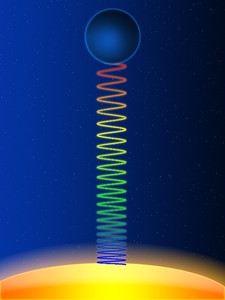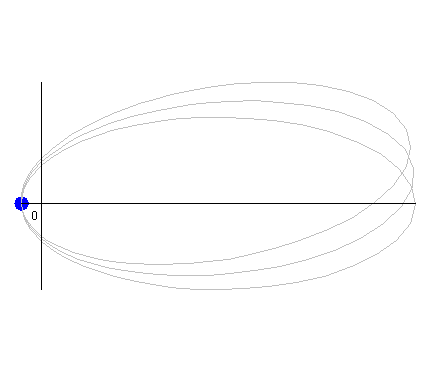
index $ \def \hieruit {\quad \Longrightarrow \quad} \def \slechts {\quad \Longleftrightarrow \quad} \def \SP {\quad ; \quad} \def \MET {\quad \mbox{with} \quad} \def \EN {\quad \mbox{and} \quad} \def \half {\frac{1}{2}} $
Indeed there is an obvious similarity between Coulomb's Law of electricity and Newton's Law of gravity:
$$
F = \frac{q_1 q_2}{4\pi\epsilon_0 r^2} \quad \sim \quad F = G \frac{m_1 m_2}{r^2}
$$
Here $F=$ force, $q=$ electric charge, $m=$ mass, $r$ = distance between point charges/masses,
$\epsilon_0=$ dielectric constant of the vacuum, $G=$ gravity constant.
Electricity goes hand in hand with magnetism. And the two are related via the speed of an
electromagnetic wave:
$$
c = \frac{1}{\sqrt{\epsilon_0\mu_0}} \quad \Longrightarrow \quad \mu_0 = \frac{1}{\epsilon_0 c^2}
$$
Here $c=$ speed of light, $\mu_0=$ magnetic permeability of free space. Analogously we could write:
$$
G \sim \frac{1}{4\pi\epsilon_0} \quad \Longrightarrow \quad
\mu_0 = \frac{1}{\epsilon_0 c^2} \sim \gamma = \frac{4\pi G}{c^2}
$$
Where $\,\gamma\,$ is sort of gravitational equivalent of $\,\mu_0\,$.
At first the following question must be raised.
Can Maxwell's equations be derived from Coulomb's Law and Special Relativity?. The answer is affirmative.
Indeed Special Relativity, together with the assumptions of charge invariance and Coulomb's law,
can be employed for a derivation of Maxwell's equations. It may thus be suggested that quite an analogous procedure
can be used for gravity. Which is exactly what has been done, by Oliver Heaviside, quite a while ago, resulting in A GRAVITATIONAL AND ELECTROMAGNETIC
ANALOGY, the GEM equations of
GravitoElectroMagnetism.
The existence of Gravitational Waves may be one of the consequences, analogously to
the existence of electromagnetic waves.
Can gravitoelectromagnetism stand the (other) tests that are supposed to be empirical evidence for General Relativity?
What are the Tests of general relativity?
Quote: The first three tests, proposed by Albert Einstein in 1915, concerned
Published articles about these issues do not receive unanimous enthusiasm,
especially when it comes to probably the most significant of all, the first one:

# Gravitational constant
G := 6.67408*10^(-11);
# Speed of light
light := 299792458;
# Mass of our sun
sun := 1.989*10^(30);
# Cogravity factor
Cogravity := evalf(4*Pi*G/light^2);
# That something with
# the dimension of length
Length := Cogravity*sun;
Length := 18560.71274 # 18.6 km
Mercury (planet) data are copied from Wikipedia:
Perihelion := 46001200; # km
Orbital_period := 0.240846; # years
# Length of one arc second in km
second := evalf(2*Pi*Perihelion/(360*60*60));
# Number of orbital periods in a century
number := 100/Orbital_period;
# Estimate of perihelion shift
shift := number*(Length/1000)/second;
shift := 34.55502278
The experimental value as well as the value calculated with General Relativity theory is $42.98$ arcseconds.
So what we anyway have is a correct order of magnitude, if calculated eventually with Cogravitation / Gravitoelectromagnetism.
 | is our third and last classical test on General Relativity. Quote from the Wikipedia reference: Since this prediction arises directly from the equivalence principle, it does not require any of the mathematical apparatus of general relativity, and its verification does not specifically support general relativity over any other theory that incorporates the equivalence principle. The result follows by employing the law increase of (relativistic) kinetic energy = decrease of (common) potential energy, with $m=$ mass photon, $c=$ lightspeed, $g=$ gravitational acceleration, $y=$ height, $h=$ Planck's constant, $\nu$ = frequency and $\,h\nu=mc^2\,$. $$ d(mc^2) = -m.g.dy \hieruit h\,d\nu = -\frac{h\nu}{c^2}g\,dy \hieruit \frac{d\nu}{\nu} = -\frac{g\,dy}{c^2} $$ An alternative formulation works with wavelength $\,\lambda\,$ instead of frequency $\,\nu\,$. $$ \nu = \frac{c}{\lambda} \hieruit d\nu = -\frac{c}{\lambda^2}d\lambda \hieruit \frac{d\nu}{\nu} = -\frac{d\lambda}{\lambda} \hieruit \frac{d\lambda}{\lambda} = \frac{g\,dy}{c^2} $$ |
So it seems that we have finished already the tests as originally proposed by Einstein.
From Relativity Reexamined at page 54-55 we quote:
The experimental " proofs " of general relativity were:
1. Deflection of light rays passing near the sun, observed during eclipses. These were very inaccurate experiments with individual
errors of 100% and averaged errors of 30%. The theory is not safe because it assumes an ideal vacuum near the sun's surface,
while we can observe very powerful explosions of matter and radiation from the sun.
2. The rotation of Mercury's perihelion. An apparently good check was proven largely accidental by Dicke (1967).
3. The redshift of spectral lines in a gravitational field. The Pound experiments brilliantly prove the result with 1% accuracy,
but a very simple reasoning, using the mass $\,h\nu/c^2\,$ of a photon $\,h\nu\,$, is enough to make the prediction.
Tests of general relativity in modern times
shall not be considered further. The reason is that they are often done the other way around. Ipse est: since we know
that Einstein's theory is infallible, it may be concluded that it explains the phenomena we observe. In this way,
General Relativity has become sort of a self-fulfilling prophecy. Furthermore the progress of image technology is such that
advanced observation can hardly be distinguished from advanced animation.
As a conclusion: There is no experimental check to support
the very heavy mathematical structure of Einstein.
And there are many other indications that General Relativity is an over the top theory, built on quicksand, as found
for example in Gravity and Antigravity by David Pratt.